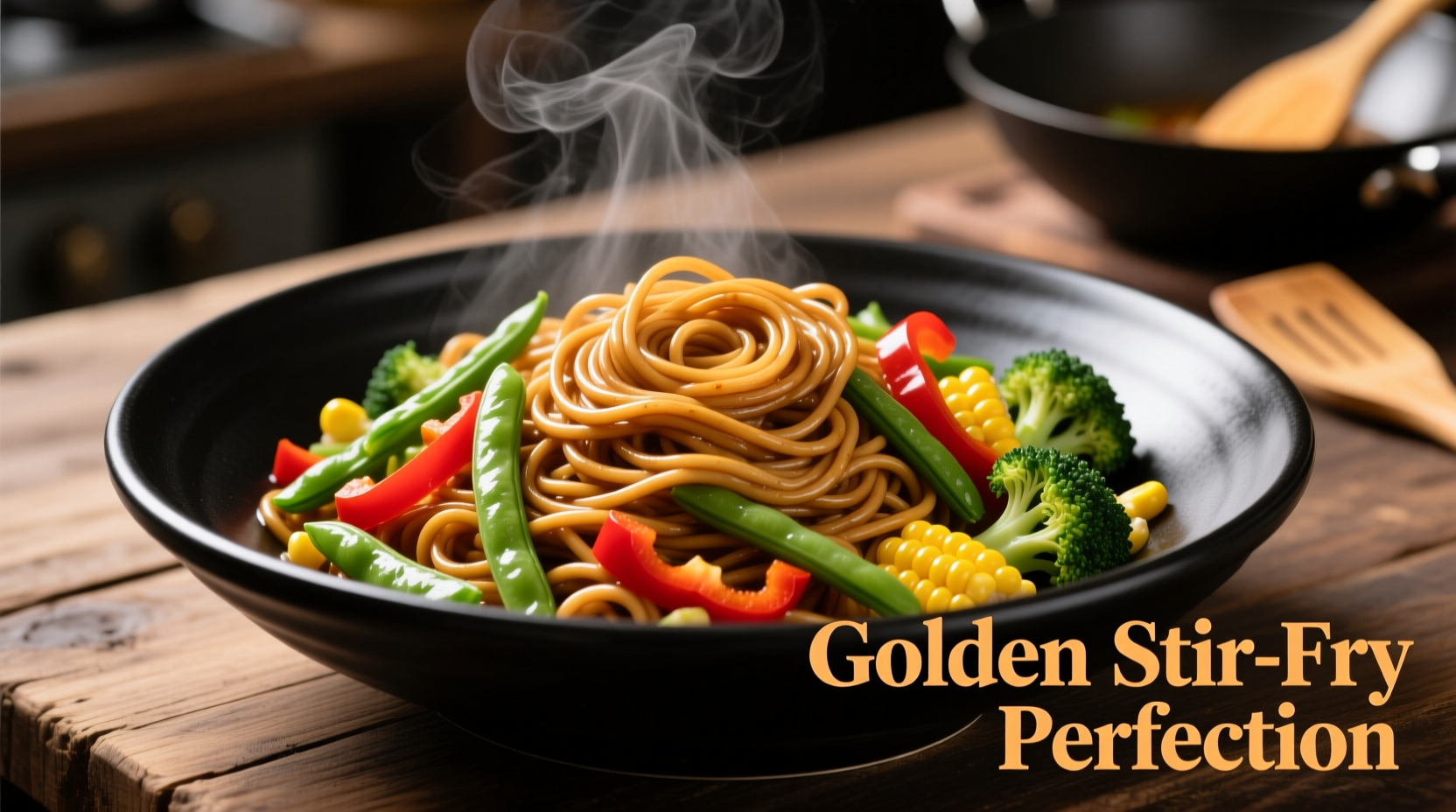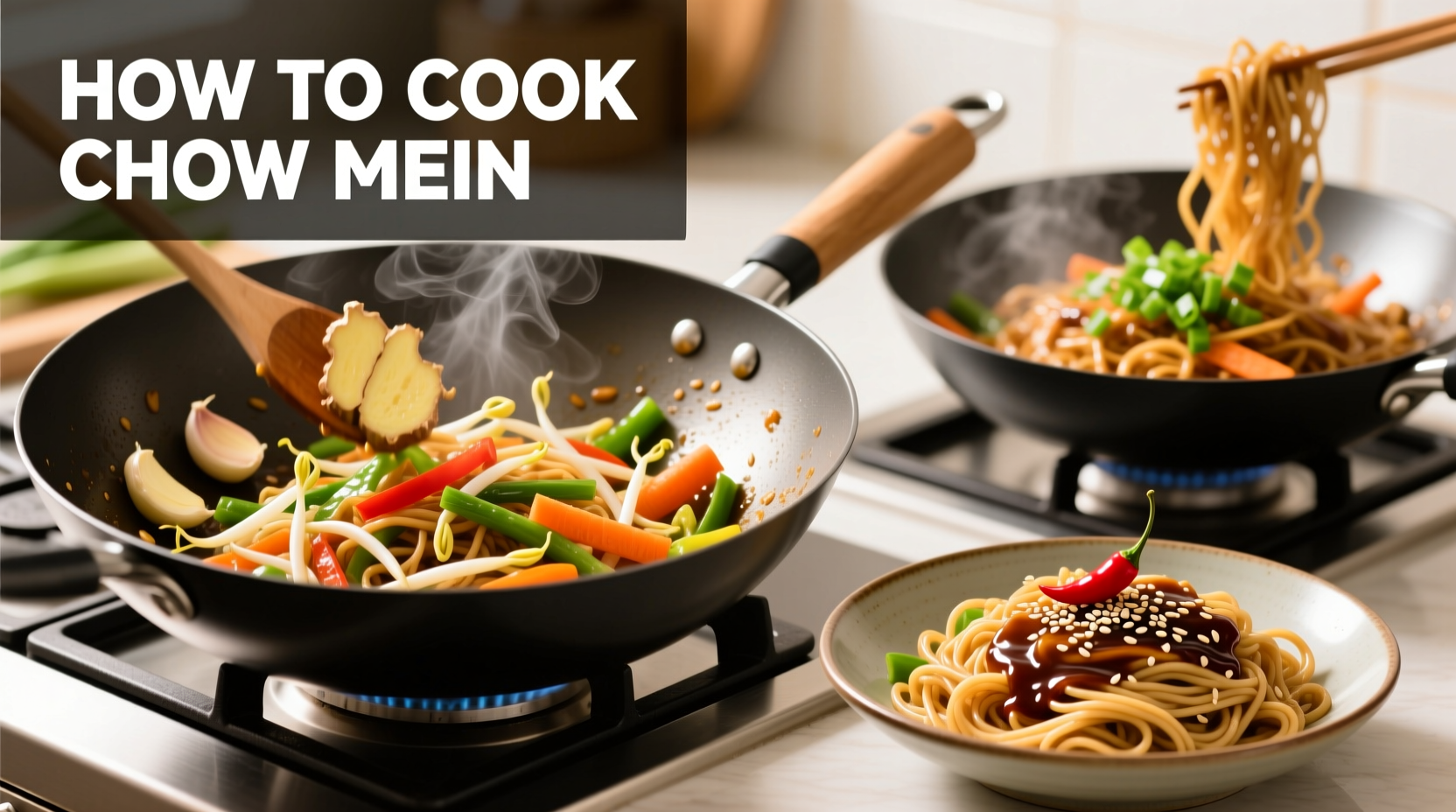Learn how to cook chow mein with this complete guide that delivers authentic flavor and perfect texture every time. The key is using properly prepared egg noodles, high-heat stir-frying in sequence, and a balanced sauce with soy sauce, sesame oil, and oyster sauce. This step-by-step method works whether you're using chicken, shrimp, or vegetables as your protein.
Understanding Chow Mein Styles and Origins
Chow mein, meaning "fried noodles" in Chinese, has evolved into distinct regional variations. Traditional Chinese versions focus on soft, steamed noodles stir-fried with vegetables and protein, while American Chinese restaurants developed a crispy version with deep-fried noodles topped with gravy.
| Style | Origin | Texture | Key Characteristics |
|---|---|---|---|
| Steamed Chow Mein | Cantonese tradition | Soft, slightly chewy | Noodles stir-fried with ingredients, minimal sauce |
| Crispy Chow Mein | American Chinese adaptation | Crispy base with soft top | Deep-fried noodles served under saucy toppings |
| Hong Kong Style | Southern China | Crispy bottom, soft top | Noodles pan-fried to create signature crispy layer |
The Evolution of Chow Mein Techniques
Chow mein originated in northern China where wheat-based noodles were staple foods. When Chinese immigrants brought their culinary traditions to America in the late 19th century, they adapted recipes using available ingredients. According to culinary historian Yong Chen's research in Chop Suey, USA: The Story of Chinese Food in America, the crispy version emerged in American Chinese restaurants as a practical solution when fresh noodles weren't available. Traditional Chinese versions maintained the soft, stir-fried approach that highlights the "wok hei" or "breath of the wok"—that distinctive smoky flavor achieved through proper high-heat cooking.
Essential Ingredients for Authentic Flavor
The foundation of great chow mein lies in ingredient quality and proper preparation. Unlike many online recipes, authentic chow mein requires specific techniques for each component.
Noodle Selection and Preparation
Use 8 ounces of fresh egg noodles for best results—they provide the ideal chewy texture that holds up to stir-frying. If unavailable, dried thin egg noodles work well when properly prepared. Never skip the par-cooking step: boil noodles for 2 minutes less than package instructions, then rinse in cold water and toss with 1 teaspoon of oil to prevent sticking. This technique, documented in Harold McGee's On Food and Cooking, creates the perfect texture foundation for stir-frying.
Sauce Components for Balanced Flavor
The sauce makes or breaks your chow mein. Combine:
- 3 tablespoons soy sauce (use reduced-sodium for better control)
- 1½ tablespoons oyster sauce (vegetarian alternative: mushroom sauce)
- 1 tablespoon sesame oil
- 1 teaspoon sugar
- ½ teaspoon white pepper
- 2 tablespoons chicken or vegetable broth
Mix these ingredients before cooking—you'll need them ready during the fast-paced stir-fry process. The sugar balances saltiness while white pepper adds subtle heat without visible specks.
Step-by-Step Cooking Process
Success with chow mein depends on proper sequence and timing. Follow these steps precisely for restaurant-quality results:
Preparation Essentials
Before heating your wok, have everything ready—chow mein cooks too quickly for mid-process prep. Julienne 1 cup each of cabbage and carrots, and prepare ½ cup bean sprouts. Cut 8 ounces of protein (chicken, shrimp, or tofu) into uniform ½-inch pieces. Keep your sauce mixture and par-cooked noodles nearby.
The Critical Stir-Fry Sequence
- Heat your wok or large skillet over high heat until smoking hot (this takes 3-4 minutes)
- Add 2 tablespoons oil, swirling to coat the surface
- Cook protein until just done (2-3 minutes), then remove
- Add 1 tablespoon oil, stir-fry hard vegetables (carrots) for 1 minute
- Add soft vegetables (cabbage, bean sprouts) and cook 1 minute
- Return protein to wok, add noodles and sauce mixture
- Toss everything together for 2-3 minutes until noodles are heated through
- Finish with 1 teaspoon sesame oil off-heat
The entire stir-fry process should take no more than 7 minutes. According to wok expert Grace Young in The Breath of a Wok, maintaining high heat throughout is crucial for achieving "wok hei"—that distinctive restaurant-quality flavor. Never crowd the wok; cook in batches if necessary.

Common Mistakes and How to Avoid Them
Most home cooks make these critical errors when attempting chow mein:
Noodle Texture Problems
Overcooked noodles become mushy and break apart during stir-frying. Undercooked noodles remain too firm and don't absorb flavors. The solution: par-cook noodles to al dente, then finish cooking them in the wok with the sauce. This two-stage cooking method ensures perfect texture.
Insufficient Heat Management
Many home stoves can't reach restaurant wok heat levels, but you can compensate. Use the highest possible heat setting, work in small batches, and ensure your wok is properly preheated. If ingredients steam instead of sizzle when added, your pan isn't hot enough—a common issue documented in culinary studies at the Culinary Institute of America.
Storage and Reheating for Leftovers
Store chow mein in an airtight container in the refrigerator for up to 3 days. When reheating, use a hot wok or skillet with a teaspoon of oil rather than a microwave—this restores texture and prevents sogginess. Add a splash of broth or water if needed to refresh the dish. Never freeze chow mein as the noodles become unpleasantly soft upon thawing.
Popular Chow Mein Variations
Once you've mastered the basic technique, try these authentic variations:
Vegetarian Chow Mein
Substitute mushroom sauce for oyster sauce and use tofu or extra vegetables. Add wood ear mushrooms and bamboo shoots for authentic texture. For best results, use homemade vegetable broth in your sauce mixture.
Shanghai-Style Chow Mein
Use thicker noodles and a slightly sweeter sauce with a touch more sugar. Include bok choy and pork instead of chicken. The Shanghai version typically has a richer, darker sauce that clings to the noodles.
Frequently Asked Questions
What's the difference between chow mein and lo mein?
Chow mein means "fried noodles" and features stir-fried noodles that develop slight crispness, while lo mein ("tossed noodles") uses fully cooked noodles mixed with sauce. Chow mein has a drier texture with more pronounced wok hei, while lo mein is saucier and softer.
Can I make chow mein without a wok?
Yes, a large cast-iron or carbon steel skillet works well as an alternative. The key is using a pan that can withstand high heat and has sloped sides for easy tossing. Avoid non-stick pans as they can't reach the necessary high temperatures for proper stir-frying.
Why are my chow mein noodles sticking together?
Noodles stick when they're overcooked or not properly coated with oil after boiling. Par-cook noodles to al dente, rinse in cold water, then toss with 1 teaspoon of oil before stir-frying. Work quickly when adding noodles to the wok to prevent clumping during cooking.
How can I get that restaurant-quality smoky flavor at home?
Achieving "wok hei" requires extremely high heat. Preheat your wok until smoking, work in small batches, and keep ingredients moving constantly. Some chefs add a tiny splash of Shaoxing wine at the end to enhance the smoky aroma. Don't overcrowd the wok, as this lowers the temperature and causes steaming instead of searing.
What vegetables work best in chow mein?
Traditional chow mein uses cabbage, carrots, and bean sprouts. Other excellent options include bell peppers, snow peas, and baby corn. Add harder vegetables first (carrots) and delicate ones later (bean sprouts) to ensure proper cooking. Avoid watery vegetables like zucchini that can make your chow mein soggy.











 浙公网安备
33010002000092号
浙公网安备
33010002000092号 浙B2-20120091-4
浙B2-20120091-4